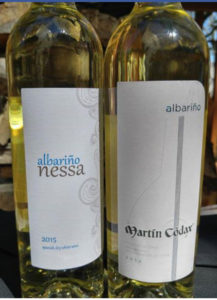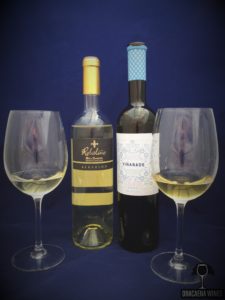I must admit it, I didn’t know anything about Albariño. In fact, I couldn’t recall ever hearing it mentioned and I know I had never tasted it before. So when Protocol Wine Studio was offering an educational session on this grape varietal, I jumped with both feet and signed up! Before the session even began, I did some research and was amazed by the entire Rías Biaxas region.
Before I get into the wines we sampled here are some quick facts about the DO Rías Baixas.
- The region was designated solely because of the Albariño grape.
- It is located in the Galicia region of northwestern Spain
- Albariño shares the same mineral-rich soils and cool climate as the Loire Valley, New Zealand, and the Rhine.
- Galicia is often referred to as Green Spain
- Rías Baixas’ more than 2,200 hours of sunshine per year
2015 Gran Vinum Nessa (SRP $17)
This wine comes from the Val do Salnés region. It poured  blonde in color with aromas of grapefruit, lemon grass and citrus. On the palate we were delighted by citrus, grass, floral and lichee. It had a medium body and a medium finish with a nice crisp acidity. From their website:
blonde in color with aromas of grapefruit, lemon grass and citrus. On the palate we were delighted by citrus, grass, floral and lichee. It had a medium body and a medium finish with a nice crisp acidity. From their website:
Piñeiro Cores family has grown vineyards for generations. We first cultivated small vineyards and gradually reorganized and replaced the original grape variety with Albarino’s grapes. Slowly but also with persistence, our grandparents continued growing Albarino grapes on small plots of land across the Rias Baixas region. Adegas Gran Vinun was created in 2002 to continue the family style.
2014 Martin Códax (SRP $16.99)
The wine is also from Val do Salnés region. Also poured blonde in color. But was a completely different animal. This wine greeted us with aromas of lemon zest and flint. It had a very tight nose initially, but opened up nicely as it warmed up. I thought this wine was on the tart side with flavors of lemon pith and I got a hint of dishwater. It was a light bodied wine with a short somewhat bitter finish. From their website:
Bodegas Martín Códax was founded in 1986 and was named after the most known Galician troubadour whose medieval poems, the oldest of Galician-Portuguese language, are preserved. In the poems, the troubadour sings to love and to the sea of our coastline.
Interestingly, the Martin Códax improved as it warmed up, but since the Nessa was vibrant and crisp from the get go, I did not see a large difference between the flavors as it warmed up. Of these two, I enjoyed the Nessa more. In fact of the six wines I will discuss in this post, Nessa is my winning pick!
2014 Rectoral do Umia Viñablade (SRP $15.00)
This wine poured dandelion in color and had aromas of peach pit, nut, grapefruit  and honey and is also from the Val do Salnés region. Granny smith apple flavors were in your face followed by a slightly oxidized nuttiness. It was a light bodied wine with a short (+) finish. This wine is also from the Val do Salnés region. Vinabade means “Abbot’s Vineyards” – reference to monks that brought Albariño to region From their website:
and honey and is also from the Val do Salnés region. Granny smith apple flavors were in your face followed by a slightly oxidized nuttiness. It was a light bodied wine with a short (+) finish. This wine is also from the Val do Salnés region. Vinabade means “Abbot’s Vineyards” – reference to monks that brought Albariño to region From their website:
Our winery Rectoral do Umia, belonging to the D.O. Rías Baixas, is located in the Salnés Valley where the Albariño grape traditionally develops its maximum quality and strength. This winery, founded in 2009, has been created following the spirit, philosophy and values that inspire our business culture, with a Knowhow developed throughout the more than 50 years of activity of the Group.
We produce wines of excellent quality, with the latest technology and under strict criteria to ensure excellence that is consistent throughout the year.
2015 Señorioo de Rubiós Robaliño (SRP $18.00)
The wine poured banana in color. Aromas of fresh cut grass, hay and grapefruit. Our palate found flavors of grapefruit, grass, minearality, citrus rind, and sea salt. The aromas were more intense than the flavors. The wine was light bodied with a short(+) finish. Unlike the previous three wines, this wine came from the Condado do Tea region which has more rainfall and fog. I loved that this winery was started by a group of locals got together to start this winery. The Condado region where the wine is made is known for cottage cheese and honey! From their website:
In late 2003 a group of 57 people, the founding partners, made this dream a reality by establishing the Bodega Coto Redondo (Coto Redondo Winery). The winery currently has 105 partners working together to maintain the tradition, history and quality that these wines deserve.
Of these two wines, I would have to choose Robaliño as my preference. I am definitely an acid head when it comes to these wines, and I enjoy the light and crisp more than the fuller bodied wines.
2014 Veiga Naum (SRP $15.00)
The wine poured blonde in color with aromas of peach, grapefruit and  honeydew. Flavors of grapefruit with a hint of acidity on the finish. This wine was not as crisp as a Sauvignon Blanc but is definitely more complex. It was a light bodied wine with a medium(+) finish. From their website:
honeydew. Flavors of grapefruit with a hint of acidity on the finish. This wine was not as crisp as a Sauvignon Blanc but is definitely more complex. It was a light bodied wine with a medium(+) finish. From their website:
The Artacho family had a deep wine tradition when in 1890 they founded Bodegas Riojanas together with Rafael Carreras. Signs of this tradition are the stone door built in 1799 to provide access to the family vineyards and is now preserved at the entrance to our winery, and very specially the prizes awarded to their wines before that foundation, as the golden of the Universal Exposition in Barcelona in 1888.
2014 ATTIS Xion (SRP $13.86)
The wine poured canary in color. It had aromas of honeysuckle, lemon and nut. Flavors of honey, peach pit, citrus and salinity. It had a short finish, the flavor just kind of vanished. It is a fuller bodied Albariño, and a completely different profile than the others. The winery is located in the center of the” Val del Salnés region. As stated on their website:
Totally integrated to the environment, the area of winemaking and aging is underground, dug in granitic stone, keeping the same temperature all the year. Moreover, we use the most advanced technology in the control of fermentation temperature of our musts, in the filtration and in the bottling of our wines.
Within these two wines, I would choose to sip on the Veiga. Again, the crispness and acidity seem to be what draws me towards these wines. I am completely astonished by the fact that these six wines, although all Albariños and all from the same DO, are exceptionally different from each other.
Each of these wines are required to be 100% Albariño in order to be labeled Rías Baixas Although there are similarities within the general scope of the wines, like salinity, grapefruit and honey, they are exceptionally different on the palate. But we learned in the twitter sessions that the winemakers choose grapes from their grape growers to tweak the finished wine to fit what they like. Additionally, the different subregions of the DO Rías Biaxas have different climates showing how much mother nature plays a role!
We are continuing to learn more about this versatile grape in the upcoming weeks. If you are trying to figure out whether you would like Albariño, maybe these two comments from fellow winestudio students will help you decide. Debbie Gioquindo, CSW wrote “Albarino is good for people who only drink Sauvignon Blanc” and William Pollard Jr. stated, “Also good for racy Riesling drinkers.” Please join us on Tuesday nights at 9pm EST. It’s easy to follow along, just use #WineStudio. Even better go to your favorite wine shop and pick up a few bottles of Albariño.
~Sláinte!
Great post! We discovered Albarino on a trip last year that included Spain and we really enjoyed it. We’re going back to Spain in September and we’ll definitely be doing more “research”
Wow. I would love to see Spain. So many places I haven’t been. It’s great when you can “research” on vacation!
Albarino is wonderful! Fantastic especially with seafood – that’s a typical local pairing. So jealous of all your Albarino studying, sounds like a incredible tasting. Is #WineStudio a new thing? Haven’t heard of it before and would love to join.
I have joined a few of the sessions. You can find them on facebook and in the link in the post. I think they have been around for awhile, not sure, but I’ve heard of them at least a year. It is such a wonderful experience to work with them.